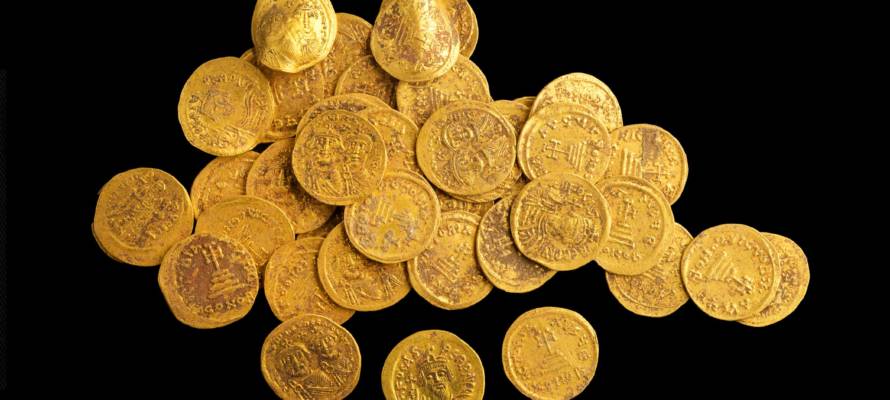“The discovery of the coin hoard may also shed light on the economy of the city of Banias during the last 40 years of Byzantine rule,” noted Dr. Yoav Lerer of the Israel Antiquities Authority.
By TPS
A treasure of 44 pure gold coins was recently chanced upon and discovered in archaeological excavations carried out by the Israel Antiquities Authority (IAA) at the site of Paneas (later known as Banias), within the Hermon River Nature Reserve in the northern tip of the country, prior to connecting the adjacent Druze holy site Maqam Nabi Khadr to the national electricity grid.
Dr. Gabriela Bijovsky, an IAA numismatic expert, examined the coin hoard, composed entirely of gold solidus coins, and identified some coins of Emperor Phocas (602–610 CE), and many coins minted by Emperor Heraclius (610–641 CE). The latest coins of Heraclius date the coin hoard to the time of the Muslim Conquest in 635 CE.
Dr. Yoav Lerer, Director of the excavation on behalf of the IAA, said that “the coin hoard, weighing about 170 grams, was concealed within the base of an ashlar stone wall at the time of the Muslim conquest. The discovery reflects a specific moment in time, when we can imagine the owner concealing his fortune in the threat of war, hoping to return one day to retrieve his property. In retrospect, we know that he was less fortunate.”
“The discovery of the coin hoard may also shed light on the economy of the city of Banias during the last 40 years of Byzantine rule,” he noted.
“Most of the coins are of the Byzantine Emperor Heraclius,” adds Dr. Bijovsky, “and what is particularly interesting is that in his early years as emperor, only his portrait was depicted on the coin, whereas after a short time, the images of his sons also appear. One can actually follow his sons growing up – from childhood until their image appears the same size as their father, who is depicted with a long beard.”
In the excavation, which took place in the northwestern residential quarter of the ancient city of Banias, the remains of buildings, water channels and pipes, a pottery kiln, bronze coins, and fragments of many pottery, glass, and metal artifacts, were found. The finds date to the end of the Byzantine period, the early seventh century CE, and to the early Middle Ages, the 11th–13th centuries.
Banias, now a National Park, is an archaeological site that was settled around a large spring in several periods, first established by the Canaanites, who dedicated a shrine to the god Baal. In the Hellenistic period, Banias served as a cultic site to the god Pan from whence the original Greek name of the site. The settlement reached its peak in the Early Roman period, when Herod the Great, and his son Philip II, entirely rebuilt the city and named it Caesarea Philippi, in honor of the Roman emperor Augustus.
